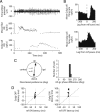Golgi cells operate as state-specific temporal filters at the input stage of the cerebellar cortex
- PMID: 21159970
- PMCID: PMC3073632
- DOI: 10.1523/JNEUROSCI.3513-10.2010
Golgi cells operate as state-specific temporal filters at the input stage of the cerebellar cortex
Abstract
Cerebellar processing of incoming information begins at the synapse between mossy fibers and granule cells, a synapse that is strongly controlled through Golgi cell inhibition. Thus, Golgi cells are uniquely positioned to control the flow of information into the cerebellar cortex and understanding their responses during behavior is essential to understanding cerebellar function. Here we show, for the first time, that Golgi cells express a unique oculomotor-related signal that can be used to provide state- and time-specific filtering of granule cell activity. We used newly established criteria to identify the unique electrophysiological signature of Golgi cells and recorded these neurons in the squirrel monkey ventral paraflocculus during oculomotor behaviors. We found that they carry eye movement, but not vestibular or visual, information and that this eye movement information is only expressed within a specific range of eye positions for each neuron. In addition, simultaneous recordings of Golgi cells and nearby mossy fibers revealed that Golgi cells have the opposite directional tuning of the mossy fiber(s) that likely drive their responses, and that these responses are more sluggish than their mossy fiber counterparts. Because the mossy fiber inputs appear to convey the activity of burst-tonic neurons in the brainstem, Golgi cell responses reflect a time-filtered negative image of the motor command sent to the extraocular muscles. We suggest a role for Golgi cells in the construction of forward models of movement, commonly hypothesized as a major function of the cerebellar cortex in motor control.
Figures








Similar articles
-
Cerebellar cortex granular layer interneurons in the macaque monkey are functionally driven by mossy fiber pathways through net excitation or inhibition.PLoS One. 2013 Dec 20;8(12):e82239. doi: 10.1371/journal.pone.0082239. eCollection 2013. PLoS One. 2013. PMID: 24376524 Free PMC article.
-
Movement-related inputs to intermediate cerebellum of the monkey.J Neurophysiol. 1993 Jan;69(1):74-94. doi: 10.1152/jn.1993.69.1.74. J Neurophysiol. 1993. PMID: 8433135
-
Characterization in vivo of bilaterally branching pontocerebellar mossy fibre to Golgi cell inputs in the rat cerebellum.Eur J Neurosci. 2009 Jan;29(2):328-39. doi: 10.1111/j.1460-9568.2008.06572.x. Epub 2008 Dec 11. Eur J Neurosci. 2009. PMID: 19077121
-
Detection of sequences in the cerebellar cortex: numerical estimate of the possible number of tidal-wave inducing sequences represented.J Physiol Paris. 2003 Jul-Nov;97(4-6):591-600. doi: 10.1016/j.jphysparis.2004.01.016. J Physiol Paris. 2003. PMID: 15242668 Review.
-
Climbing fibers mediate vestibular modulation of both "complex" and "simple spikes" in Purkinje cells.Cerebellum. 2015 Oct;14(5):597-612. doi: 10.1007/s12311-015-0725-1. Cerebellum. 2015. PMID: 26424151 Review.
Cited by
-
Granule cell ascending axon excitatory synapses onto Golgi cells implement a potent feedback circuit in the cerebellar granular layer.J Neurosci. 2013 Jul 24;33(30):12430-46. doi: 10.1523/JNEUROSCI.4897-11.2013. J Neurosci. 2013. PMID: 23884948 Free PMC article.
-
Strategies to decipher neuron identity from extracellular recordings in the cerebellum of behaving non-human primates.bioRxiv [Preprint]. 2025 Jan 29:2025.01.29.634860. doi: 10.1101/2025.01.29.634860. bioRxiv. 2025. Update in: J Neurosci. 2025 Aug 6;45(32):e0230252025. doi: 10.1523/JNEUROSCI.0230-25.2025. PMID: 39975199 Free PMC article. Updated. Preprint.
-
GABA-A Inhibition Shapes the Spatial and Temporal Response Properties of Purkinje Cells in the Macaque Cerebellum.Cell Rep. 2015 May 19;11(7):1043-53. doi: 10.1016/j.celrep.2015.04.020. Epub 2015 May 7. Cell Rep. 2015. PMID: 25959822 Free PMC article.
-
Golgi cell-mediated activation of postsynaptic GABA(B) receptors induces disinhibition of the Golgi cell-granule cell synapse in rat cerebellum.PLoS One. 2012;7(8):e43417. doi: 10.1371/journal.pone.0043417. Epub 2012 Aug 22. PLoS One. 2012. PMID: 22937048 Free PMC article.
-
Sensory coding by cerebellar mossy fibres through inhibition-driven phase resetting and synchronisation.PLoS One. 2011;6(10):e26503. doi: 10.1371/journal.pone.0026503. Epub 2011 Oct 26. PLoS One. 2011. Retraction in: PLoS One. 2012;7(4). doi: 10.1371/annotation/0b18c274-2427-482d-add4-aa20001c0e98. PMID: 22046297 Free PMC article. Retracted.
References
-
- Chadderton P, Margrie TW, Häusser M. Integration of quanta in cerebellar granule cells during sensory processing. Nature. 2004;428:856–860. - PubMed
-
- Chan-Palay V, Palay SL. The synapse en marron between golgi II neurons and mossy fibers in the rat's cerebellar cortex. Z Anat Entwicklungsgesch. 1971;133:274–287. - PubMed
-
- D'Angelo E, De Zeeuw CI. Timing and plasticity in the cerebellum: focus on the granular layer. Trends Neurosci. 2009;32:30–40. - PubMed
Publication types
MeSH terms
Grants and funding
LinkOut - more resources
Full Text Sources
